Texas
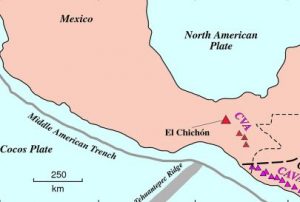 El Chichón was a volcano, in southern Mexico, that had not erupted for 130 years, meaning that no one who was alive on March 29, 1982 had ever seen it erupt. For most of the residents, who lived in the shadow of El Chichón, also known as Chinhonal, the 4,500 foot mountain seemed to pose no danger. Even when it did erupt, 130 years earlier, the eruption was minor. The people assumed that it was a dead volcano, and so ignored its potential for destruction and enjoyed the fertile soil its volcanic past provided.
El Chichón was a volcano, in southern Mexico, that had not erupted for 130 years, meaning that no one who was alive on March 29, 1982 had ever seen it erupt. For most of the residents, who lived in the shadow of El Chichón, also known as Chinhonal, the 4,500 foot mountain seemed to pose no danger. Even when it did erupt, 130 years earlier, the eruption was minor. The people assumed that it was a dead volcano, and so ignored its potential for destruction and enjoyed the fertile soil its volcanic past provided.
Then, in late 1981, two geologists, who were intrigued by hot springs and steaming gaps in the earth near the volcano, began an investigation that revealed increased seismic activity and the possibility of a major eruption of the volcano. Unfortunately, their report was ignored, because of the volcano’s quiet past. Thier complacence would 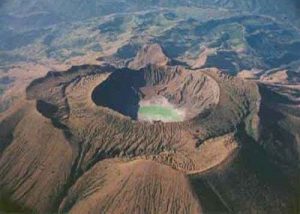 prove to be their downfall. Even when the ground began shaking on the night of March 28, the people did not heed the warning signs.
prove to be their downfall. Even when the ground began shaking on the night of March 28, the people did not heed the warning signs.
Then, at 5:15am the following morning, March 29, 1982, no one could miss the combination earthquake and eruption that exploded the mountain. The combination of the earthquake and the volcanic eruption turned the mountain into a crater. Ash was sent flying 60,000 feet in the air. About 150 people were killed when their roofs collapsed under raining volcanic debris. Two days later, ash from the eruption fell in Austin, Texas, many hundreds of miles to the north. The eruptions continued for over a week.
Most of the approximately 2,000 people killed by the eruption died from exposure to the pyroclastic flow, a  volatile mix of hot particles and gas. El Chichón lost its entire top, leaving only a large crater 1,000 feet deep, and less than 700 feet high, which was now shorter than the surrounding hills. Two more major eruptions occurred on April 3rd and 4th. In these eruptions, the debris was sent so high that it came down as virtual landslide on the surrounding villages. Trees and buildings were no match for the dirt and rocks. The debris also blocked streams, causing flooding in the area. Nine entire villages were destroyed and more than 100 square miles of farmland were unusable for years. Overall, the energy released by the eruptions, which were similar in scope to the Mount Saint Helens eruptions in Washington in 1980, was the equivalent of 8,000 one kiloton atomic bombs.
volatile mix of hot particles and gas. El Chichón lost its entire top, leaving only a large crater 1,000 feet deep, and less than 700 feet high, which was now shorter than the surrounding hills. Two more major eruptions occurred on April 3rd and 4th. In these eruptions, the debris was sent so high that it came down as virtual landslide on the surrounding villages. Trees and buildings were no match for the dirt and rocks. The debris also blocked streams, causing flooding in the area. Nine entire villages were destroyed and more than 100 square miles of farmland were unusable for years. Overall, the energy released by the eruptions, which were similar in scope to the Mount Saint Helens eruptions in Washington in 1980, was the equivalent of 8,000 one kiloton atomic bombs.
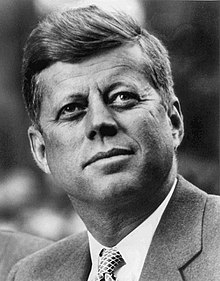 When President Kennedy was assassinated in Dallas, Texas on November 22, 1963, I was just a little girl of 8 years. I vividly remember how I found out about it. A neighbor girl came running across the street from her house to mine. I was on my way to meet her. It was in the middle of the street that I heard the news…our President had been assassinated. I was horrified, like most Americans were that day. It all seemed too impossible to comprehend. I knew nothing of politics back then, of course, I just knew that something horrible had happened to my country…the whole country. A nation doesn’t lose a president for any reason and not suffer from that loss. The loss of the president…the only president lost during office in my entire lifetime…not that attempts weren’t made or threatened, was so shocking to me. It’s something I will never forget.
When President Kennedy was assassinated in Dallas, Texas on November 22, 1963, I was just a little girl of 8 years. I vividly remember how I found out about it. A neighbor girl came running across the street from her house to mine. I was on my way to meet her. It was in the middle of the street that I heard the news…our President had been assassinated. I was horrified, like most Americans were that day. It all seemed too impossible to comprehend. I knew nothing of politics back then, of course, I just knew that something horrible had happened to my country…the whole country. A nation doesn’t lose a president for any reason and not suffer from that loss. The loss of the president…the only president lost during office in my entire lifetime…not that attempts weren’t made or threatened, was so shocking to me. It’s something I will never forget.
After the assassination, there was much controversy about what happened. Immediately…as always happens when anything big happens, there is a special commission appointed to find out what happened. I can see how that is important sometimes, but I don’t know that I think these commissions are always unbiased. As with most events such as these, there were, and still are, many people who do not think that Lee Harvey Oswald acted alone…or that he was even involved at all. Seven days after the assassination, Johnson appointed the President’s Commission on the Assassination of President Kennedy to investigate Kennedy’s death, and on this day, September 24, 1964, the Warren Commission, headed up by Chief Justice Earl Warren, gave their report to President Lyndon B  Johnson, who had been vice-president to President Kennedy, and therefore became president upon his death.
Johnson, who had been vice-president to President Kennedy, and therefore became president upon his death.
Following the report, those who disagreed thought that the whole thing was a conspiracy. The conspiracy theories were many, including the Mob, Cuban exiles, military leaders, the secret service, and even Lyndon Johnson. The Warren Commission concluded that Oswald was the “lone gunman” in the assassination, but that failed to satisfy some who witnessed the attack and others whose research found conflicting details in the commission’s report. Critics of the Warren Commission’s report believed that additional ballistics experts’ conclusions and a home movie shot at the scene disputed the theory that three bullets fired from Oswald’s gun could have caused Kennedy’s fatal wounds as well as the injuries to Texas Governor John Connally, who was riding with the president in an open car as it traveled through Dallas’ Dealey Plaza that day. Eventually, another congressional investigation was conducted in 1979, but that committee reached the same conclusion as the Warren Commission. During its almost year-long investigation, the Warren Commission reviewed reports by the Federal Bureau of Investigation, Secret Service, Department of State and the attorney general of Texas. It also pored over Oswald’s personal history, political affiliations 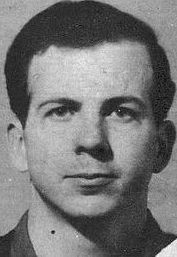 and military record. The Warren Commission listened to the testimony of 552 witnesses and even traveled to Dallas several times to visit the site where Kennedy was shot.
and military record. The Warren Commission listened to the testimony of 552 witnesses and even traveled to Dallas several times to visit the site where Kennedy was shot.
The enormous volume of documentation from the investigation was placed in the National Archives and much of it is now available to the public. Access to Kennedy’s autopsy records, though, are highly restricted. To view them requires membership in a presidential or congressional commission or the permission of the Kennedy family. I am one of those who find the conclusion of the Warren Commission to be…very simplistic, and hard to believe. I have watched several documentaries about the assassination, including the video of the actual event, and it just doesn’t make sense. Be that as it may, the commissions have spoken, and nothing more will ever be done about it. The many people involved are all gone now, so there is no one to say what really happened. So we only know what we have been told, but most of it doesn’t make sense to me.
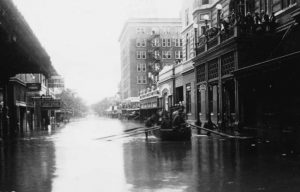 As the world watches, with sadness, the news of the flooding in Houston from Hurricane Harvey, I am reminded of another Texas flood that severely damaged a Texas city. This flood wasn’t from a hurricane exactly, but rather like Harvey, the flooding occurred because of too much rain for the ground to handle. Early that September, the remnants of a Category 1 hurricane brought heavy rains to areas of Mexico, as well as the state of Texas, particularly in the San Antonio area. On September 4, a tropical cyclone had developed in the southwestern Gulf of Mexico near the Bay of Campeche. It moved slowly in a general westward direction. Then, the storm reached hurricane intensity on September 7 prior to making landfall south of Tampico, Mexico the following day. The storm weakened over land, and lost cyclonic characteristics later that day, but a nearby high-pressure area forced the remnants of the system northward into Texas. So it was that was on September 7, 1921 in San Antonio, Texas, after some of the heaviest rainfall ever recorded in Texas…at least up to that time…dumped an astounding 23.11 inches of rain in the San Antonio area in less than a day.
As the world watches, with sadness, the news of the flooding in Houston from Hurricane Harvey, I am reminded of another Texas flood that severely damaged a Texas city. This flood wasn’t from a hurricane exactly, but rather like Harvey, the flooding occurred because of too much rain for the ground to handle. Early that September, the remnants of a Category 1 hurricane brought heavy rains to areas of Mexico, as well as the state of Texas, particularly in the San Antonio area. On September 4, a tropical cyclone had developed in the southwestern Gulf of Mexico near the Bay of Campeche. It moved slowly in a general westward direction. Then, the storm reached hurricane intensity on September 7 prior to making landfall south of Tampico, Mexico the following day. The storm weakened over land, and lost cyclonic characteristics later that day, but a nearby high-pressure area forced the remnants of the system northward into Texas. So it was that was on September 7, 1921 in San Antonio, Texas, after some of the heaviest rainfall ever recorded in Texas…at least up to that time…dumped an astounding 23.11 inches of rain in the San Antonio area in less than a day.
In some areas of Texas, the rainfall was even worse, but those areas somehow didn’t have the same potential for devastating floods. The precipitation peaked over Central Texas, where the highest rainfall amount measured was 40 inches near Thrall, Texas. This was the fourth highest tropical cyclone-related rainfall total in Texas since record keeping began. Similarly, an observation of 36.40 inches elsewhere in Williamson County, Texas ranked as the sixth-highest tropical cyclone-related rainfall total for the state. The high precipitation totals set nationwide records which would stand for several years. Like Hurricane Harvey, that storm stalled and the rain just kept coming.
The immense amount of rain quickly overwhelmed the San Antonio River that winds through southwest Texas. The area is usually pretty dry, but on that September day, the storm that stalled over Taylor, Texas was a 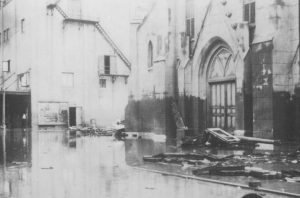 recipe for disaster. It was the heaviest single day of rainfall in the state to that time. Taylor is located 30 miles upstream from San Antonio, so when the flash flood came barreling down, it took aim on San Antonio with a vengeance. Most of the 51 flood victims were trapped in their cars by the surprise flood and drowned. Much like Houston, five to ten feet of water submerged the city’s streets, delaying an evacuation. The city was under water for nearly a week following the flood. The flood damage amounted to at least $5 million in damages in the small city that was San Antonio, at that time. In the aftermath, San Antonio embarked on a 10 year overhaul of its levee system, not knowing for sure that it would really help, but I guess they did what they knew to do.
recipe for disaster. It was the heaviest single day of rainfall in the state to that time. Taylor is located 30 miles upstream from San Antonio, so when the flash flood came barreling down, it took aim on San Antonio with a vengeance. Most of the 51 flood victims were trapped in their cars by the surprise flood and drowned. Much like Houston, five to ten feet of water submerged the city’s streets, delaying an evacuation. The city was under water for nearly a week following the flood. The flood damage amounted to at least $5 million in damages in the small city that was San Antonio, at that time. In the aftermath, San Antonio embarked on a 10 year overhaul of its levee system, not knowing for sure that it would really help, but I guess they did what they knew to do.

 In the late 19th century, America was growing. The pioneers headed west, because many couldn’t resist the lure of the tall grassy land in the midwestern and southern plains of the United States. They planned to settled there to farm. The next few decades were prosperous, but when the 1930s rolled in, so did strong winds, drought, and clouds of dust that plagued nearly 75 percent of the United States between 1931 and 1939. The Dust Bowl, as it was known, had arrived. The problem likely began in the early 1920s, when a post-World War I recession led farmers to try new mechanized farming techniques as a way to increase profits. Many bought plows and other farming equipment, and between 1925 and 1930 more than 5 million acres of previously unfarmed land was plowed. With the help of mechanized farming, farmers produced record crops during the 1931 season. However, overproduction of wheat coupled with the Great Depression led to severely reduced market prices. The wheat market was flooded, and people were too poor to buy. Farmers were unable to earn back their production costs and expanded their fields in an effort to turn a profit. The prairie was covered with wheat in place of the natural drought-resistant grasses, and to add to the problem, they left any unused fields bare. With the drought leaving much of the country severely dry, no natural grasses to hold the dirt in place, the higher than normal temperatures, and increasingly strong winds, the country was hit with what many called Black Blizzards, which were rolling dust storms driven by high winds.
In the late 19th century, America was growing. The pioneers headed west, because many couldn’t resist the lure of the tall grassy land in the midwestern and southern plains of the United States. They planned to settled there to farm. The next few decades were prosperous, but when the 1930s rolled in, so did strong winds, drought, and clouds of dust that plagued nearly 75 percent of the United States between 1931 and 1939. The Dust Bowl, as it was known, had arrived. The problem likely began in the early 1920s, when a post-World War I recession led farmers to try new mechanized farming techniques as a way to increase profits. Many bought plows and other farming equipment, and between 1925 and 1930 more than 5 million acres of previously unfarmed land was plowed. With the help of mechanized farming, farmers produced record crops during the 1931 season. However, overproduction of wheat coupled with the Great Depression led to severely reduced market prices. The wheat market was flooded, and people were too poor to buy. Farmers were unable to earn back their production costs and expanded their fields in an effort to turn a profit. The prairie was covered with wheat in place of the natural drought-resistant grasses, and to add to the problem, they left any unused fields bare. With the drought leaving much of the country severely dry, no natural grasses to hold the dirt in place, the higher than normal temperatures, and increasingly strong winds, the country was hit with what many called Black Blizzards, which were rolling dust storms driven by high winds.
Now, if you have ever been in a Haboob (Arabic meaning, blasting), which is a type of intense dust storm carried on a weather front, you have a pretty good idea of what the Dust Bowl was like, except that instead of lasting a few hours, the Dust Bowl storms continued to occur from 1931 to 1939. Now imagine 8 plus years of dust 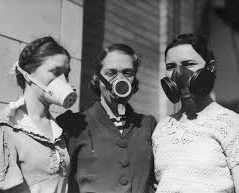 blowing everywhere!! It was in their hair, in their eyes, in their houses, and in the food. They couldn’t get away from it, and since 75 percent of the United States was in the grip of the Dust Bowl, moving didn’t help either…not to mention the fact that no one could afford to anyway. It was a disgusting situation, and it was about to get much worse. By 1932, 14 Black Blizzards were reported, and in just one year, the number increased to nearly 40. It seemed that no end was in sight, but still, the worst was yet to come.
blowing everywhere!! It was in their hair, in their eyes, in their houses, and in the food. They couldn’t get away from it, and since 75 percent of the United States was in the grip of the Dust Bowl, moving didn’t help either…not to mention the fact that no one could afford to anyway. It was a disgusting situation, and it was about to get much worse. By 1932, 14 Black Blizzards were reported, and in just one year, the number increased to nearly 40. It seemed that no end was in sight, but still, the worst was yet to come.
On the afternoon of April 14, 1935, the residents of the Plains States were forced to take cover as a Black Blizzard, blew through the region. The storm hit the Oklahoma Panhandle and Northwestern Oklahoma first, moving south for the remainder of the day. It hit Beaver around 4:00 pm, Boise City around 5:15 pm, and Amarillo, Texas, at 7:20 pm. The conditions were the most severe in the Oklahoma and Texas panhandles, but the storm’s effects were felt in other surrounding areas. The day would forever be labeled Black Sunday. It was one of the worst dust storms in American history and it caused immense economic and agricultural damage. It is estimated to have displaced 300 million tons of topsoil from the prairie area of the United States. The storm was so harsh because of the high winds that hit the area that day. The combination of drought, erosion, bare soil, and winds caused the dust to fly freely and at high speeds. The loose dust flying around was enough to inhale, and many people suffocated with the dust filling their lungs. The day was a black day for more reasons than one. It is hard to contemplate a dust storm that was so severe that people couldn’t breathe…to the point of death! Nevertheless, that was exactly what Black Sunday was like.
Following the horrible Black Blizzards of 1935, and the massive amount of damage caused by these storms, Congress passed the Soil Conservation Act, which established the Soil Conservation Service as a 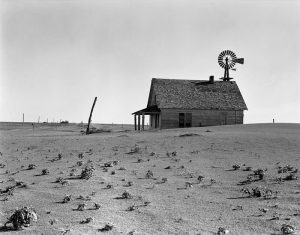
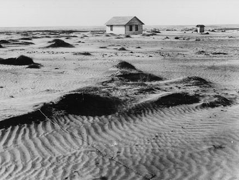 permanent agency of the USDA. The SCS was created in an attempt to provide guidance for land owners and land users to reduce soil erosion, improve forest and field land, and conserve and develop natural resources. It was the hope that the United States could prevent another Dust Bowl, and while small areas have a tendency to have dust storms, there has never been another era like the Dust Bowl era that the United States citizens suffered in the 1930s.
permanent agency of the USDA. The SCS was created in an attempt to provide guidance for land owners and land users to reduce soil erosion, improve forest and field land, and conserve and develop natural resources. It was the hope that the United States could prevent another Dust Bowl, and while small areas have a tendency to have dust storms, there has never been another era like the Dust Bowl era that the United States citizens suffered in the 1930s.
 With the decline of the oil business, comes the inevitable change of the face of oil companies. In Wyoming, that decline means layoffs and transfers to many of the people who worked for the oil companies. I really don’t know of a family that hasn’t been affected by the decline. Our family has experienced layoffs, and as in the case of my nephew, Eric Parmely, a job that is saved, by way of Texas. Eric and his wife, Ashley aren’t moving to Texas, but his job will take him to Texas for two weeks and then home for a week. I think the week at home will be really nice, but it comes at the expense of the two weeks in Texas. I know that this has been a hard change to swallow for Eric, his wife, Ashley, and their girls, Reagan and Hattie.
With the decline of the oil business, comes the inevitable change of the face of oil companies. In Wyoming, that decline means layoffs and transfers to many of the people who worked for the oil companies. I really don’t know of a family that hasn’t been affected by the decline. Our family has experienced layoffs, and as in the case of my nephew, Eric Parmely, a job that is saved, by way of Texas. Eric and his wife, Ashley aren’t moving to Texas, but his job will take him to Texas for two weeks and then home for a week. I think the week at home will be really nice, but it comes at the expense of the two weeks in Texas. I know that this has been a hard change to swallow for Eric, his wife, Ashley, and their girls, Reagan and Hattie.

Eric and Ashley live in the country, where they have chickens, goats, rabbits, and next door, at her parents house, horses. They are all totally in their element there. Of course, Ashley was raised there, so being around the animals is second nature to her. The girls also take to it like little pros, and the animals love them all. Eric and Ashley’s parents, Albert and Kari Eighmy did all the remodeling of their fixer upper home. They wouldn’t let Ashley be there, because she was pregnant, but Eric’s mom, Jennifer Parmely, who loves to clean, came and cleaned up all the construction dust, and they have a beautiful home now…all the more reason not to move to Texas. Eric has become quite handy with the things he makes. If Ashley shows him something she wants, he can probably pull it off. A good example of that is the bedroom set he made for his girls. It is the perfect setup for two little girls, and I know that they will love it for a long time. Eric is  getting…or maybe he always was…very handy at building things. His work is beautiful and solid. The workmanship of the things he makes is amazing. I think that if he wanted to, he could sell his work and make money at it…but that is another story.
getting…or maybe he always was…very handy at building things. His work is beautiful and solid. The workmanship of the things he makes is amazing. I think that if he wanted to, he could sell his work and make money at it…but that is another story.
Eric is a family man. His wife and daughters mean the world to him. Eric wants nothing more than to be at home with them, or spend time with them doing just about anything they want to do. They love being outdoors, and it doesn’t matter what season it is. Eric will make things fun for his girls. That is the sign of a good husband and dad. Today is Eric’s birthday. Happy birthday Eric!! Have a great day!! We love you!!
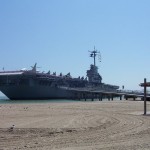 While Bob and I were in Corpus Christi, Texas in March of 2006, we had the opportunity to visit the USS Lexington, better known now, as The Blue Ghost. The ship was originally known as the Cabot, but after the USS Lexington CV-2 was lost in the Battle of the Coral Sea, she was renamed while under construction to commemorate the earlier USS Lexington. This Lexington was the fifth United States Navy ship to bear the name in honor of the Revolutionary War Battle of Lexington. In June of 1942, after the earlier USS Lexington was destroyed, workers at the shipyard submitted a request to Navy Secretary Frank Knox to change the name of a carrier currently under construction there to Lexington. Knox agreed to the proposal and Cabot was renamed as the fifth USS Lexington on 16 June 1942. She was launched on 23 September 1942, sponsored by Mrs Theodore Douglas Robinson. Lexington was commissioned on February 17, 1943.
While Bob and I were in Corpus Christi, Texas in March of 2006, we had the opportunity to visit the USS Lexington, better known now, as The Blue Ghost. The ship was originally known as the Cabot, but after the USS Lexington CV-2 was lost in the Battle of the Coral Sea, she was renamed while under construction to commemorate the earlier USS Lexington. This Lexington was the fifth United States Navy ship to bear the name in honor of the Revolutionary War Battle of Lexington. In June of 1942, after the earlier USS Lexington was destroyed, workers at the shipyard submitted a request to Navy Secretary Frank Knox to change the name of a carrier currently under construction there to Lexington. Knox agreed to the proposal and Cabot was renamed as the fifth USS Lexington on 16 June 1942. She was launched on 23 September 1942, sponsored by Mrs Theodore Douglas Robinson. Lexington was commissioned on February 17, 1943.
I can’t say for sure if this Frank Knox was any relation to my husband’s Knox ancestors, but it wouldn’t  surprise me at all, since the Knox family was into politics, and even included a connection to President James Knox Polk. While I was originally writing this because on this day, December 5, 1941, the prior USS Lexington headed out to the Battle of Midway…a battle that it never made it to, because of the Japanese attack on Pearl Harbor. That Lexington made it back to Pearl Harbor on December 13, 1941, so it was not much help. Later, the prior USS Lexington was destroyed in the Battle of Coral Sea, triggering the renaming of the USS Lexington that Bob and I saw.
surprise me at all, since the Knox family was into politics, and even included a connection to President James Knox Polk. While I was originally writing this because on this day, December 5, 1941, the prior USS Lexington headed out to the Battle of Midway…a battle that it never made it to, because of the Japanese attack on Pearl Harbor. That Lexington made it back to Pearl Harbor on December 13, 1941, so it was not much help. Later, the prior USS Lexington was destroyed in the Battle of Coral Sea, triggering the renaming of the USS Lexington that Bob and I saw.
The USS Lexington we saw was referred to as a “ghost” ship by the Japanese for her tendency to reappear after reportedly being sunk. This, coupled with the ship’s dark blue camouflage scheme, led the crew to refer to her as “The Blue Ghost”. There were rumors during the war that the ship was so badly damaged it had to be scuttled at one point, but a newly built aircraft carrier was immediately deployed with the same name, in an effort to demoralize the Japanese. I’m sure the whole situation was a serious frustration to the Japanese, but for Bob and me the legend that ship had 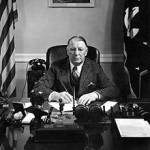 become was something we found quite interesting.
become was something we found quite interesting.
That said, I now find something new to draw my interest…namely Navy Secretary Frank Knox. One thing I have noticed is that in many families, certain names seem to be used over and over. In Bob’s family, there is a Frank Knox, and in that lineage there are Williams and Johns. The same is the case with Navy Secretary Frank Knox’s lineage. For that reason, I expect that a connection exists, and with a little work, I think I will find it, if it exists. I like the challenges that come from trying to connect the missing links in our family, and when I can tie it to something I have personally seen, it is an even more exciting quest.
 Every time disaster strikes, it seems like we always remember where we were and what we were doing the moment we found out about it. Moments like September 11, 2001, the Kennedy assassinations, Reagan’s shooting, and for me, the Space Shuttle Challenger explosion, are permanently imprinted on my mind. It had been so well televised. It was to be the first time an American civilian was going into space, and she was a teacher. It was an exciting event for America, and especially for the schools and the school children, who felt like they were suddenly center stage within the space program. The nation watched as the Teacher in Space candidates went through the paces to decide which teacher would be chosen. Finally the decision was made, and out of all the candidates, a woman, Christa McAuliffe stood alone as the chosen one. It was exciting for her, the school where she taught, and her family. It was excitement mixed with anxiousness, because there was always that element of danger, that you know is possible, but you never really believe would come to pass…until it does.
Every time disaster strikes, it seems like we always remember where we were and what we were doing the moment we found out about it. Moments like September 11, 2001, the Kennedy assassinations, Reagan’s shooting, and for me, the Space Shuttle Challenger explosion, are permanently imprinted on my mind. It had been so well televised. It was to be the first time an American civilian was going into space, and she was a teacher. It was an exciting event for America, and especially for the schools and the school children, who felt like they were suddenly center stage within the space program. The nation watched as the Teacher in Space candidates went through the paces to decide which teacher would be chosen. Finally the decision was made, and out of all the candidates, a woman, Christa McAuliffe stood alone as the chosen one. It was exciting for her, the school where she taught, and her family. It was excitement mixed with anxiousness, because there was always that element of danger, that you know is possible, but you never really believe would come to pass…until it does.
I was disappointed that I had to bowl on the morning that had been chosen for the launch of the Challenger. I had hoped that I could catch some of it on the television set the bowling alley had. As secretary of the league, I  had duties to perform when I got there, but I was immediately approached by one of the bowlers, who said, “Did you hear that the space shuttle exploded?” It was so unthinkable, that my mind first thought that it exploded before anyone was in it, but deep down, I knew that this was a huge disaster. I prayed that some of them would live through it, while knowing in my heart, that they could not have lived through it. It was hard to bowl that day, but there was nothing else we could do. The televisions were on, and we watched as the explosion was played over and over again. Then we went home, and watched more of it at home. Sometimes, I think that people have a tendency to think that if they watch a disaster over and over, that maybe somehow it will have a different outcome…as irrational as that sounds.
had duties to perform when I got there, but I was immediately approached by one of the bowlers, who said, “Did you hear that the space shuttle exploded?” It was so unthinkable, that my mind first thought that it exploded before anyone was in it, but deep down, I knew that this was a huge disaster. I prayed that some of them would live through it, while knowing in my heart, that they could not have lived through it. It was hard to bowl that day, but there was nothing else we could do. The televisions were on, and we watched as the explosion was played over and over again. Then we went home, and watched more of it at home. Sometimes, I think that people have a tendency to think that if they watch a disaster over and over, that maybe somehow it will have a different outcome…as irrational as that sounds.
This whole disaster gave me a different view of the space shuttle, and so when we had the opportunity to visit the Johnson Space Center in Houston, Texas, I found the view of the space shuttle, and all it’s inner workings to be the most interesting. Standing inside the shuttle display, I felt a mixture of excitement and a little dread. It wasn’t that I was concerned for me, but rather that the Challenger’s lost astronauts came back to my mind. I felt a tiny bit of their excitement, and yet I knew that they would never get to fully live their dream, but would die  tragically just 73 second into the flight. Just a little over a minute into their dream. So close, and yet so suddenly it was over…forever. There would be no second chance for them, and this event would bring a lasting emptiness to their families. Events like these scar the people of nation. We may not think of them every day, but when we are reminded of them, such as today, on the 29th anniversary of the event, we can’t help but to be taken back to the day of the event. We can vividly picture each and every second of it, knowing that the loss of life is enormous…knowing that not only are those who died, gone from their families now, but the families are left to pick up the pieces. And we are left remembering exactly where we were when we heard the tragic news.
tragically just 73 second into the flight. Just a little over a minute into their dream. So close, and yet so suddenly it was over…forever. There would be no second chance for them, and this event would bring a lasting emptiness to their families. Events like these scar the people of nation. We may not think of them every day, but when we are reminded of them, such as today, on the 29th anniversary of the event, we can’t help but to be taken back to the day of the event. We can vividly picture each and every second of it, knowing that the loss of life is enormous…knowing that not only are those who died, gone from their families now, but the families are left to pick up the pieces. And we are left remembering exactly where we were when we heard the tragic news.
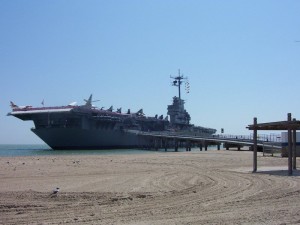
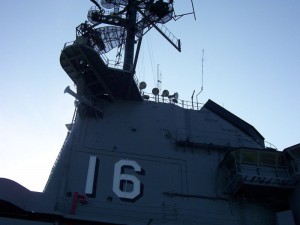 While Bob and I were in Texas on vacation in April of 2006, we had the wonderful opportunity to visit the USS Lexington…The Blue Ghost. This ship has a long and interesting history, and one I didn’t really know all that much about when I visited the ship. The ship we saw is not the original USS Lexington, but rather the one that replaced the original. The USS Lexington that we saw has an amazing history too…it is, in fact, a legend that was named for the American Revolution’s Battle of Lexington. On December 5, 1941, the original USS Lexington, which was one of the two largest aircraft carriers the United States had during World War II, was making its way across the Pacific in order to carry a squadron of dive bombers to defend Midway Island from an anticipated Japanese attack. The attack they anticipated did occur, but not where it had been expected. The attack was lodged on Pearl Harbor instead. The USS Lexington turned around and headed for Pearl Harbor, arriving on December 13th. That Lexington was later sunk.
While Bob and I were in Texas on vacation in April of 2006, we had the wonderful opportunity to visit the USS Lexington…The Blue Ghost. This ship has a long and interesting history, and one I didn’t really know all that much about when I visited the ship. The ship we saw is not the original USS Lexington, but rather the one that replaced the original. The USS Lexington that we saw has an amazing history too…it is, in fact, a legend that was named for the American Revolution’s Battle of Lexington. On December 5, 1941, the original USS Lexington, which was one of the two largest aircraft carriers the United States had during World War II, was making its way across the Pacific in order to carry a squadron of dive bombers to defend Midway Island from an anticipated Japanese attack. The attack they anticipated did occur, but not where it had been expected. The attack was lodged on Pearl Harbor instead. The USS Lexington turned around and headed for Pearl Harbor, arriving on December 13th. That Lexington was later sunk.
In early May, the first USS Lexington returned to the South Pacific to assist the USS Yorktown to fight against the Japanese offensive in the Coral Sea. On May 7th and 8th of 1942 planes from the USS Lexington helped sink the small Japanese aircraft carrier Shoho and participated in attacks on the large carriers Shokaku and Zuikaku. But, she was a major target of Japanese carrier planes and received two torpedo and three bomb hits. Initially, it appeared that the damage control efforts were successful, but she was racked by gasoline explosions early on the afternoon of May 8th. The fires were out of control, and it was clear that the Lexington was breathing her last breath. The ship was abandoned by her crew and it sunk. It was the first US aircraft carrier to be lost in World War II.
The second Lexington began its journey into fame on February 17, 1943, and it would serve longer and set more records than any other carrier in US Naval history. Originally to be named the Cabot, the name was changed after the sinking of the original Lexington in the Coral Sea. The Lexington became a part of the Fifth Fleet at Pearl Harbor. The ship took part in nearly every major operation in the Pacific Theater, serving 21 months in combat. It was here that the Lexington became famous in her own right. The Japanese radio station, the Tokyo Rose was always spreading rumors and propaganda. The station declared the Lexington sunk at least four times, but was proven wrong at the next battle, when the Lexington returned to the fight. I guess it must have been in an effort to save face that the Tokyo Rose dubbed the Lexington The Blue Ghost, indicating that it was a ghost ship returning to haunt the Japanese again and again. All the hard work paid off in the end though. The Lexington participated in the Great Marianas Turkey Shoot, the Battle of Leyte Gulf, and the Battle of the Philippine Sea. She received the Presidential Unit Citation and 11 Battle Stars during her service in World War II, and she was the first battleship into Tokyo Harbor for the Japanese peace treaty signing.
By the time we visited the second USS Lexington, she had been a museum since October of 1992. The ship had been decommissioned in August of 1990, after serving as a training ship for naval aviators in Pensacola, Florida since 1962. She was moved to her permanent location in Corpus Christi, Texas in January of 1992. We had the wonderful opportunity to explore the ship to our hearts’ content while we were there. It was quite interesting to us. I didn’t know much about how things were on a ship, but I found myself amazed over and over again. The way the crew lived, seemed so archaic to me, but I suppose that anyone who has ever served on a ship would tell me that it was all very normal. Finding your way around seemed so difficult to me, and I know we would have been lost repeatedly, had they not marked the directions with arrows on the floor and walls. It was hard to imagine just what being on board this ship in the midst of a battle must have felt. I don’t think anyone goes to war without a measure of fear. Nevertheless, there was no going back for the men, and later, women who 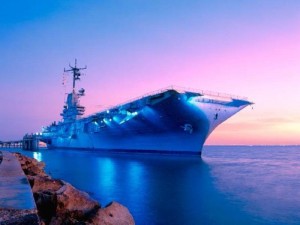
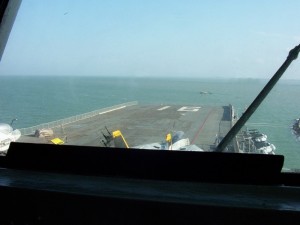 served on the Lexington. The Lexington was the first aircraft carrier to have women stationed on board. These men and women served courageously and honorably, some giving their lives on the Lexington fighting the battles that were laid out before her. Knowing the history of this great ship leaves me with an entirely new perspective about what an awesome ship it was, and it makes me glad I had the opportunity to tour the USS Lexington.
served on the Lexington. The Lexington was the first aircraft carrier to have women stationed on board. These men and women served courageously and honorably, some giving their lives on the Lexington fighting the battles that were laid out before her. Knowing the history of this great ship leaves me with an entirely new perspective about what an awesome ship it was, and it makes me glad I had the opportunity to tour the USS Lexington.
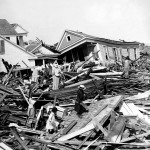
 Eight years ago, Bob and I took a trip to Texas, during which we visited Galveston. Like my Dad, who visited Galveston during his Rest and Relaxation period during World War II, I found that I absolutely loved Galveston. For Dad and for me, the Galveston area was like taking a step back in time, to when life was much less hurried. People fished before going to work, and it almost seemed like the time to get to work was even a little flexible. That is almost like the old west…basically unheard of for the most part, these days. And, maybe it wasn’t really like that, but nobody seemed stressed!! How could that be? For whatever reason, they all seemed to have an attitude of gratitude that they were still here on this earth. It was amazing.
Eight years ago, Bob and I took a trip to Texas, during which we visited Galveston. Like my Dad, who visited Galveston during his Rest and Relaxation period during World War II, I found that I absolutely loved Galveston. For Dad and for me, the Galveston area was like taking a step back in time, to when life was much less hurried. People fished before going to work, and it almost seemed like the time to get to work was even a little flexible. That is almost like the old west…basically unheard of for the most part, these days. And, maybe it wasn’t really like that, but nobody seemed stressed!! How could that be? For whatever reason, they all seemed to have an attitude of gratitude that they were still here on this earth. It was amazing.
I don’t imagine that Galveston was always that way, but maybe it was. Nevertheless, I have to wonder if that attitude of gratitude came to Galveston after the 1900 hurricane that practically destroyed the city and killed between 6,000 and 12,000 people, with most official reports listing it at 8,000. The hurricane made landfall in Galveston on September 8, 1900 with winds estimated at 145 miles per hour…a Category 4 hurricane. It was the deadliest hurricane in US history and second only to Hurricane Katrina in total cost. The city of Galveston was all but destroyed by this hurricane, which occurred before names were assigned to hurricanes.
It was after the 1900 hurricane that it was decided that Galveston must have a seawall to better protect it from these devastating hurricanes. At the time of that hurricane, the highest point in the city of Galveston was only 8.7 feet above sea level. The storm surge was 15 feet, and it washed over the entire island. Over 3,600 homes were destroyed. Only a few buildings survived…mostly the solidly build mansion and houses along the Strand District. Those are tourist attractions today, and I am here to say that they are beautiful.
The story of the 1900 hurricane has left me in a bit of a state of wonder, especially when I think of the seawall that I saw. It didn’t look like something that could stop the surge of a hurricane, but over the years, Galveston 
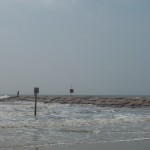 has been mostly protected from the hurricanes that have come through. I have thought of the people of Galveston, and what a virtually stress free place it is, and it occurs to me that when so many of the people a town housed are gone in an instant, it would leave you with a different perspective on what is important and what isn’t. You would also think twice about getting upset about things that really don’t make any difference in the long run. Maybe that is what gives the people of Galveston an attitude if gratitude, and maybe it is what makes it such a peaceful place to visit.
has been mostly protected from the hurricanes that have come through. I have thought of the people of Galveston, and what a virtually stress free place it is, and it occurs to me that when so many of the people a town housed are gone in an instant, it would leave you with a different perspective on what is important and what isn’t. You would also think twice about getting upset about things that really don’t make any difference in the long run. Maybe that is what gives the people of Galveston an attitude if gratitude, and maybe it is what makes it such a peaceful place to visit.
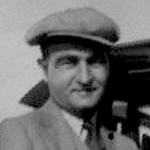 My great aunt, Mina Albertine Schumacher, who went by Minnie as a child, but Min for most of her adult life, married John Clark Spare in Fargo, North Dakota on January 8, 1921. In the years preceding their marriage, John had enlisted in the North Dakota National Guard, Company B, at the age of 17 years. His company was assigned to the Rio Grande River Patrol on the Mexican border at Mercedes, Texas. Company B was patrolling one day, and John had an empty gun, because at that point, there was not enough ammunition to go around. Basically, the men who had loaded guns would have to cover the ones who did not, in the event of anything illegal happening along the border. I suppose that was the only thing that they could do, but I have to tell you that I would not feel very comfortable being one of those guys who did not have any ammunition at the border between Mexico and the United States. I realize that these days that border is probably more dangerous than it was then, but maybe not. Many of the outlaws from both countries ran to the other country to hide out from the law in their own country.
My great aunt, Mina Albertine Schumacher, who went by Minnie as a child, but Min for most of her adult life, married John Clark Spare in Fargo, North Dakota on January 8, 1921. In the years preceding their marriage, John had enlisted in the North Dakota National Guard, Company B, at the age of 17 years. His company was assigned to the Rio Grande River Patrol on the Mexican border at Mercedes, Texas. Company B was patrolling one day, and John had an empty gun, because at that point, there was not enough ammunition to go around. Basically, the men who had loaded guns would have to cover the ones who did not, in the event of anything illegal happening along the border. I suppose that was the only thing that they could do, but I have to tell you that I would not feel very comfortable being one of those guys who did not have any ammunition at the border between Mexico and the United States. I realize that these days that border is probably more dangerous than it was then, but maybe not. Many of the outlaws from both countries ran to the other country to hide out from the law in their own country.
On that day, John was patrolling near the bridge by the encampment, with his empty gun. Suddenly, a herd of horses was seen thundering toward them. Behind the herd was Pancho Villa and his gang of bandits. The gang was in a gun fight with the men from the Third Cavalry, from whom the gang had stolen the horses. The time had come for the border patrol to do their duty. It would be the job of the ones with the ammunition to engage the enemy and assist the Cavalry. The remainder of the men would need to dive under the bridge for cover. The men immediately prepared to take their necessary positions, and with one accord, all of the men of the border patrol dived under the bridge. Unbeknownst to the men, at least until that moment, they all had unloaded guns!! While that might seem like a funny thing to see all those men diving under that bridge because they did not have the ammunition to fight in the battle that was looming down on them, my guess is that it would also be a horrifying situation to the men hiding under the bridge hoping the battle would continue to go on down the road, and not circle back.
Following his time as part of the border patrol, John was called to the Guard full time, and assigned to guard the Fargo Armory, just as bombs were being placed at strategic points around the country to blow them up if it became necessary. I think it is a bit ironic that on his first assignment, John had no ammunition, and at his second assignment, when he was just going on 19 years of age, he was guarding a building that held larges stores of ammunition. I have to think that he must have thought to himself, “Where was all this ammunition when we were at the border?” John’s company would be taken into the Federal Army as the United States entered World War I. John would later re-enlist and fight in both world wars before he finally decided that he had served his time. I’m sure my Great Aunt Min was glad when he came home for good.

